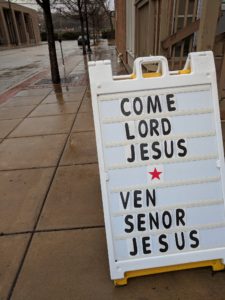City Mission: A Catalyst for Becoming a Missionary Disciple

“… if you pour yourself out for the hungry and satisfy the desire of the afflicted, then shall your light rise in the darkness and your gloom be as the noonday. And the Lord will guide you continually … and make your bones strong; and you shall be like a watered garden, like a spring of water, whose waters fail not.” (Isaiah 58:10, 11)
Since 1992, my family and I have been deeply involved in disaster relief efforts around the country, from Florida (post-Hurricanes Andrew and Ian) to Mississippi (post-Hurricane Katrina) to West Virginia (post-flooding) to Indiana (post-tornadic destruction) to Tennessee (post-tornadic destruction) to Baltimore City (post-human generated difficulties), etc. My wife, Nancy, and I—and all five of our children (now adults)—were greatly impacted by these experiences, especially <in discovering> how they ‘taught us’ what it means to be a missionary disciple of Jesus Christ; and now, over three decades later, thousands of lives have been transformed because of these intentional acts of mission. Our first City Mission was launched in 2014. For this year’s event, City Mission: Baltimore and Beyond ’24, we decided to be even more intentional in this work and keep this one question before us, specifically in light of Isaiah 58:10,11: What does it mean to be a missionary disciple?
For the sake of clarity, there are two types of missional opportunities we’ve offered over the years: First, Cross Country Mission (CCM), which involves disaster response-type work following a natural catastrophic event beyond our home base, somewhere across the country; or, City Mission (CM) which was born out of CCM to serve more locally and bridge between the City and Suburbia, addressing human-generated needs. (see: CM Part 1 and CM Part 2)
I think this past year’s experiences have helped us to see more clearly that these more intensive (extraordinary) missional encounters have been highly effective in serving as a catalyst for igniting the participants, the laos/λαός-People of God, into the more ordinary and daily work of mission in their homes, places of work, schools, etc. In other words, they have the capacity to shake us—the Church—out of our timidity, and even lethargy, and pursue both the Great Commission (Mt. 28:16-20) and the Great Shema (Mk. 12:28-30) with a fiercer determination—To become missionary disciples!
These ventures have pushed us far beyond our comfort zone, from only knowing what it means to be a disciple into actually living out our discipleshipthrough intentional, boots-on-the-ground missional activity. In other words, these experiences enabled us to live a more incarnational, Christ-centered discipleship as it took on real bones, sinew, flesh, and blood; specifically, as we were baptized into the mission field! Just a couple of years ago, one of our young adults described CM as “a raw and unfiltered experience of what it means to be the Church!” Truly, these ‘encounters’ have served as a catalyst for becoming a missionary disciple.
My daughter, Sarah, who experienced her first CCM at 14 y/o and is now 33 y/o, has also reflected on what it means to be a missionary disciple. Here is an excerpt from what she wrote after our most recent CCM this past February and CM in May: “In disaster zones, where everything is stripped away, where chaos abounds, order is lost, and hope seems lost with it … it is here that a new source of Life is found. A new perseverance, a ‘restored strength and ever-flowing spring’ begins to pour from within you (Isaiah 58:10-12). Suddenly your own petty complaints of the day don’t matter. The madness and the rush of a ‘controlled’ life is gone. All that you see, all that you think about, is before you: an opportunity to love the people who have lost it all. The people who *really* have something to complain about, yet don’t. They’re full of thankfulness for life itself, not the things in it. The presence of the Holy Spirit is so tangible in these places where distraction is low and pain is high. Lives are changed, and hearts are broken for the things that break His. The Cross becomes what matters most; the thing we cling to, and the hope of His Resurrection and the new life to come.”
Brothers and Sisters, CCM or a CM is merely a ‘tool’ or vehicle to help build out and facilitate the work of mission; but, it has also become an all-important and much needed catalyst to embolden us to live out our calling as missionary disciples. What has the Lord placed in front of you … perhaps, to teach you … how to become a missionary disciple? Dare to step into it. His grace will lead you, every step of the way.
Becoming a missionary disciple with you … In Christ, Craig
The following pics reflect a few highlights from our most recent City Mission this past May. This year we had 12 different churches (2 LCMC and 2 NALC) from all streams of the Church (Orthodox, Catholic, Protestant, Mennonite, and Pentecostal) with participants ranging in age from 6 y/o to 80 y/o. Being multi-denominational and multi-generational is a part of our DNA and enables the participants to see a greater unity within the Church (cf. John 17:21-26).
Pre-Mission Hours







On Mission





















Resting/Playing After Working



Kairos Circle



Evening Meal, Worship and Guest Speakers



















 And yet, by the power of the Holy Spirit, turning points and breakthroughs can and do occur:
And yet, by the power of the Holy Spirit, turning points and breakthroughs can and do occur:

